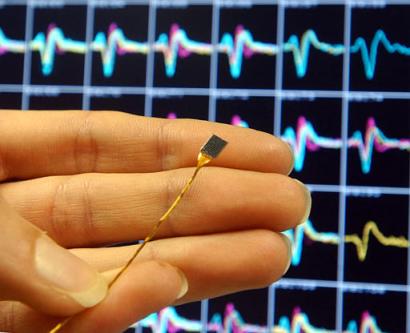The goal: to map the neural activity that occurs when thinking about an action of moving limbs, to allow paralyzed people to move. The scientists: After much progress with animals, it's time for the next step
Voila system!

Scientists will implant small computer chips in the brains of paralyzed people in order to "read their minds". American researchers from Cyberkinetics Ltd. received permission to implant the chips in the patients' skulls.
The chips will map the neural activity that occurs in the brain while the patients think about moving one of the organs. This activity will be copied to the computer in the form of code that will one day be able to operate robotic limbs. The company, located in Massachusetts, received approval from the Food and Drug Administration to begin testing the chips, which are 4 mm square.
The "brain gate" contains tiny pegs that will be implanted under the skull and penetrate one millimeter deep into the brain, where they will monitor the activity of a small group of neurons. The signals will be picked up by electrical wires that protrude from the skull, creating a slight risk of infection. The company is working on a wireless version.
The hope is that the research - which has so far been carried out on animals - can eventually help patients who have been rendered speechless by stroke or diseases such as cerebral palsy. While people may continue to live for many years with these symptoms, their quality of life is severely impaired. Other researchers are working on deciphering the way the brain sends instructions that move the limbs.
In 1998, researchers discovered that a brain implant allowed a person who was silent after a stroke to move a cursor to indicate words on a computer monitor. The following year, other scientists said that electrodes on the skulls of two patients with Lou Gehrig's disease, which damages neurons and motor skills, allowed them to spell out a message on a monitor.
"There is always some risk"
In the past, cyberkinetics experiments were already carried out in which three monkeys were given implants. These were used to record signals from the motor center - the area of the brain that controls movement - while moving a joystick in their hands. These signals were used to develop software that allowed one of the monkeys to continue moving the computer cursor with his mind. The company believes that it is the first to implant a sophisticated device inside a human brain. She hopes to finish the research in three to five years.
Patients will be asked to imagine performing a certain action, such as moving a hand a few centimeters away. Researchers will then try to identify the brain activity associated with this desire. This information could one day be fed into devices such as robotic arms, which could help patients fulfill this desire.
However, transferring the experiment from monkeys to humans is a challenge, but Richard Andersen, an expert in the field from the California Institute of Technology, who is engaged in similar research, says that the field is advanced enough to move to the next stage. "I think there is a consensus among researchers that this is the right time to move to human trials," he said.
According to him, surgeons are already implanting devices inside human brains - sometimes at great depth - to treat deafness and Parkinson's disease. "There is always a certain risk, but the benefits must also be taken into account."
Dr. Richard Epps, a neurophysiologist at the University of Bristol, told the BBC: "There has been real progress in being able to do this kind of work in animals. The next step is to write computer code that will recreate the same complex brains needed to instruct the limbs to move, but this research is an encouraging step."
